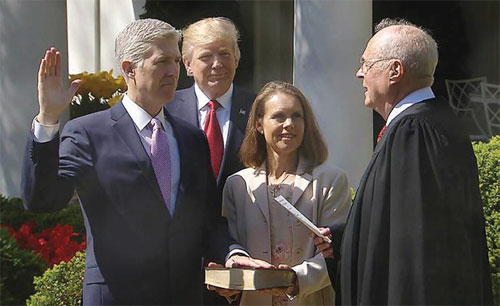By Brice Wallace
Employers could be in store for a lot of employment law changes under the President Trump administration.
That was the gist of presentations at the recent 29th annual Parsons Behle & Latimer Employment Law Seminar in Salt Lake City, although many of the comments featured “we’ll wait and see” caveats.
“Whether you support him or oppose him or like him or dislike him, the reality is that he already has had, and will continue to have, a profound impact on employment law in this country,” Derek Langton said of the president. Langton is a shareholder at the firm and a member of its employment law practice group.
“President Trump, as a candidate, really didn’t talk much about employment law issues and really since he has become president, he hasn’t talked much about employment law issues. So to some extent, we’re gazing into the crystal ball, reading tea leaves, about what we think will happen. But there are a lot of things that have happened already.”
Langton did not discuss healthcare reform, which is stalled in Congress, and travel bans, stalled in courts, but said that the most significant happening so far has been the appointment of Neil Gorsuch to the U.S. Supreme Court — an action that could have ramifications for decades to come. Gorsuch uses “originalism” in interpreting the U.S. Constitution and “textualism” in statutory interpretation, Langton said, adding that Gorsuch has been critical of Supreme Court precedents requiring judicial deference to government agencies.
“He’s taken a narrow interpretation of whistleblower suits, [and] he’s not a big fan of class actions, which leads us to believe that he will be acting in a very conservative way on the court,” Langton said.
One change that many employers “were really gearing up for” is on hold. Under the Obama administration, the Department of Labor overhauled overtime pay regulations, roughly doubling the minimum salary at which an employee can be exempt from overtime pay, to $47,476. It was scheduled to take effect last December but a November federal court action halted its implementation.
Many people expect the Trump administration to try to revert to the old standard, but if they want to change the regulation, that could take time due to a lengthy rule-making process. What’s more, Alexander Acosta, the new secretary of labor, does not appear to support the threshold doubling but has suggested he would support updating the OT rule to some degree, Langton said.
“It’s also possible that Congress might act,” he said. “There’s been a proposal that was introduced recently to increase that threshold compensation level to $36,000, but we really don’t know what’s going to happen.”
“Another biggie,” one regarding pay disparity, also is in the lurch. The Equal Employment Opportunity Commission (EEOC) has proposed changes to a report called the EEO-1 that requires companies with 100 or more employees to report annually aggregate compensation data for all employees by gender, race and ethnicity.
That form change is set to take effect in March 2018.
The question is what the Trump administration will do. It may seek to rescind the changes before the first reporting is due or may seek to revise the reporting requirements to ease the burden on employers. But if the changes do take effect, the disclosures on the form will be based on 2017 data, meaning that covered employers will need to conduct self-audits and make appropriate changes during 2017.
“This is one of those, in my view, huge quandaries for employers because if the changes do go into effect — and right now, we really don’t know what’s going to happen — if they do go into effect and employers have to report this information in March of next year, the data is going to be based on 2017. It’s going to cover the last quarter of 2017,” Langton said.
“It’s got to be one pay period between Oct. 1 and Dec. 1, 2017. The employer gets to pick which pay period is covered. But if there are pay disparities at the company during that time period that make it look to the EEOC that there is something discriminatory — either from a gender or ethnicity standpoint — it’s going to be too late to fix it. So, right now, employers are between a rock and a hard place on this EEO-1 form.”
Also, the EEOC’s new acting chair, Victoria Lipnic, voted against the pay data report proposal while on the EEOC.
“There’s no way we can tell you exactly what to do,” Langton told the audience. “I think that there’s a good chance Trump and Lipnic won’t want that to go into effect in its current format, but we don’t know. And it’s kind of a warning to employers that they need to fix those disparities now.”
Employers also should expect changes involving the National Labor Relations Board (NLRB), which is likely to revisit rules and decisions made during the prior administration. “When it becomes a Republican-majority NLRB, then I think we can reasonably expect that a lot of things that happened under the Obama administration will be rolled back,” Langton said.
Christina M. Jepson, a shareholder of Parsons Behle & Latimer and chair of its employment and labor law practice group, said new administration changes will hinge on who is appointed to lead agencies, what they will be charged to do, what their enforcement priorities will be, how they will interpret laws and which issues will be pushed. Among issues likely to be addressed involve healthcare reform, immigration, paid parental/sick leave, marijuana use, transgender accommodation and non-compete agreements, she said.
“So, the election has had quite a big impact on employment law,” Jepson said, “and I think don’t think we’ll know for a couple of years really how big that impact is going to be.”








